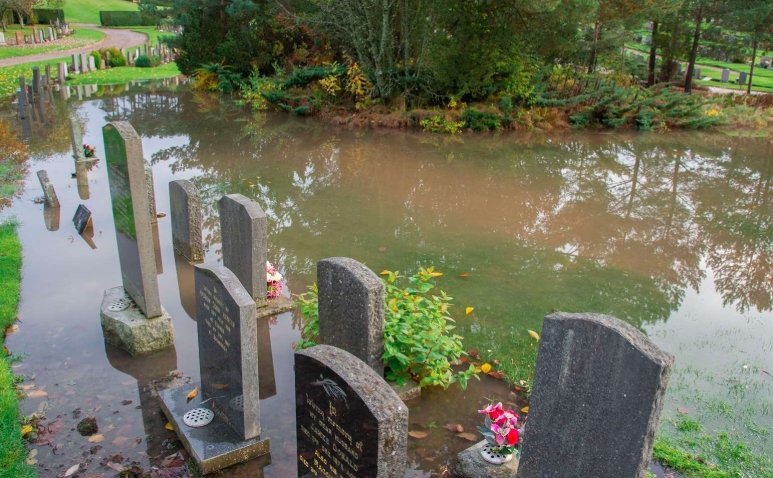Moray Council has installed a rain garden at Clovenside Cemetery in Forres to fight ongoing flooding problems. This setup now makes the site much less prone to water buildup during heavy rains, as officials report better drainage overall.
History of Flooding Challenges at Clovenside
Clovenside Cemetery, tucked behind Forbeshill in Forres, has long battled water issues. Heavy downpours often left graves in the center underwater, causing real pain for families who could not visit loved ones properly. Back in 2020, flash floods submerged headstones after intense storms, sparking calls from locals and leaders for action.
The problems worsened over winters, with the old soakaway system failing under pressure. By 2021, council teams noted that high rainfall and a sloped layout made the spot extra vulnerable. Residents shared stories of distress, like seeing water pool around memorials after just a few days of rain. This led to urgent plans for fixes, as the site saw repeat incidents that disrupted burials and visits.
In early 2025, another flood hit on New Year’s Day, drawing fresh complaints and an apology from the council for the upset caused. Such events highlighted the need for lasting solutions in this quiet Moray town, where weather patterns bring more intense storms each year.

Design and Installation of the Rain Garden
Workers put in the rain garden in 2022 after careful planning to avoid harming graves. The project cost around 56,000 pounds and replaced the broken soakaway with a smarter setup. First, they dug out over 100 tonnes of soil and bricks from the low point, then shaped a shallow dip in the ground.
This dip now holds native plants like hazel shrubs, meadow grasses, and wildflowers that thrive in wet soil. Underneath lies a layer of sandy soil topped with deep stones to speed up water absorption. Paths around the area got adjusted too, to stop extra pooling. Trees removed during work went back in along the edges, keeping the look natural.
Council experts picked this design because the cemetery’s slope made big digs risky. Screens went up during construction to shield ongoing burials, and teams paused jobs when needed. The whole effort aimed to let rainwater soak in slowly, easing the load on local drains.
How Well Does the Rain Garden Work Now
Recent checks show the rain garden doing its job most days, cutting flood risks sharply. After heavy rain this week, officials said the site handled it far better than before, with water draining quicker thanks to the plant and stone layers. A council voice noted that the system works well in normal conditions, helping the cemetery cope with storms.
Still, extreme weather can cause short term pooling, like what happened early this year during long rains. No big floods have returned since the install, but very wet spells test the limits. Experts say this setup absorbs runoff naturally, lowering overall water levels by capturing what would otherwise rush downhill.
To show the gains, here is a quick look at flood events before and after:
| Year | Flood Incident | Severity | Response |
|---|---|---|---|
| 2020 | Flash flood after storms | High, graves submerged | Calls for urgent fixes |
| 2021 | Winter repeats | Medium, path pooling | Planning rain garden |
| 2025 (Jan) | New Year’s Day water | Medium, temporary | Council apology, checks |
| 2025 (Nov) | Recent heavy rain | Low, quick drain | Positive council review1
|
This table highlights how incidents have dropped in scale since the changes.
Wider Flood Prevention Moves in Moray
Moray Council pushes hard on water risks across the region, with big funds for defenses. In 2025, they set aside over 1.2 million pounds for bridges and barriers, part of a full plan for the next year. A new coastal adaptation strategy, finished this month, covers all shore spots with steps to handle rising seas and storms.
Other spots get help too, like rain gardens at schools and parks to boost green drainage. A 258,000 pound grant this summer aids habitat fixes that fight floods while aiding wildlife. Forres sees extra work at places like Chapelton Dam, which holds back peak flows during bad weather.
These efforts tie into Scotland’s national push for tough flood rules, with Moray leading on local plans. Simple steps, such as planting more in towns, cut runoff and build resilience against climate shifts.
Here are key benefits of rain gardens in such projects:
- They soak up rainwater fast, cutting flood chances by up to 30 percent in small areas.
- Native plants draw bugs and birds, boosting local nature without much upkeep.
- Low cost over time, as they need little water or care once set up.
- Blend into sites like cemeteries, keeping a peaceful feel while working hard.
What It Means for Locals and Next Steps
Families in Forres now find more peace at Clovenside, with fewer worries about visits ruined by water. The garden not only guards graves but adds a touch of green that honors the space. Yet, with weather getting wilder, folks wonder if more tweaks could handle the worst rains fully.
Council teams watch the site closely and plan checks after big storms. Broader talks include linking this to town wide green fixes, like wildflower edges along roads. As Moray grows its flood tools, this cemetery shows how small changes bring big relief.
Share your thoughts on local flood fixes in the comments below, and pass this story to friends facing similar issues.


















